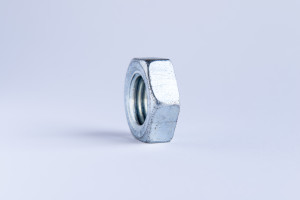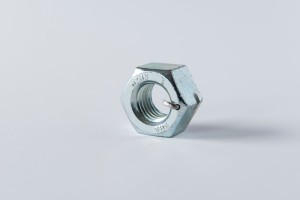Hex Nuts
Hex nuts (also referred to as finished hex nuts) are available in ASTM A563-A and compatible with low carbon steel bolts such as ASTM A307, ASTM F1554 grade 36, SAE grade 2, and AASHTO M183. SAE grade 5 and grade 8 nuts are also available in a finished pattern. Since hot-dip galvanizing typically adds 2.2 to 5 mils of thickness to the threaded portion of a fastener, galvanized hex nuts are tapped oversize to compensate for the corrosion resistant coating on the bolts.
Heavy Hex Nuts
Heavy hex nuts are slightly larger and thicker than standard (finished) hex nuts. There are numerous grades and the heavy pattern is typically used for large diameter and high strength bolts. Since hot-dip galvanizing typically adds 2.2 to 5 mils of thickness to the threaded portion of a fastener, galvanized heavy hex nuts are tapped oversize to compensate for the corrosion resistant coating on the bolts.
Coupling Nuts
Hex couplers are used to connect two pieces of threaded material. Hex and heavy hex couplers are threaded right hand. If a right hand-left hand coupler is needed, consider using a sleeve nut. Since hot-dip galvanizing typically adds 2.2 to 5 mils of thickness to the threaded portion of a fastener, galvanized couplers are tapped oversize to compensate for the corrosion resistant coating on the bolts.
Jam Nuts
Hex jam nuts are thinner than a standard hex nut but have the same dimension across the flats and corners. Hex jam nuts have two common applications. A jam nut can be threaded onto a bolt and run tight against the standard nut which will lock the nut in place and prevent it from backing off. Jam nuts are sometimes used for leveling purposes as well. Since hot-dip galvanizing typically adds 2.2 to 5 mils of thickness to the threaded portion of a fastener, galvanized hex jam nuts are tapped oversize to compensate for the corrosion resistant coating on the bolts.
Locking Nuts
Lock nuts are available in numerous styles, grades and finishes. The term “lock nut” is not meant to imply that there is an indefinite permanency of fixity once used. Most locknuts can be removed and some can even be reused if removed correctly. Lock nuts are most commonly available in ASTM A563 Grades A and DH and ASTM A194 Grade 2H. They are manufactured with a standard hex or a heavy hex pattern. Two of the most common lock nut styles are Anco and Tri-Lok. The Anco style is a self-locking nut with a ratchet pin that is made from stainless steel. This ratchet pin slides along the threads as the nut is spun onto the bolt and prevents the nut from backing off. One benefit to using an Anco style lock nut is that the ratchet pin can be bent back so that the nut can be easily removed if needed. The Tri-Lok style is a “prevailing-torque” locknut which is frictionally resistant to rotation due to the thread distortion on the top thread of the nut.
Since hot-dip galvanizing typically adds 2.2 to 5 mils of thickness to the threaded portion of a fastener, galvanized lock nuts are tapped oversized to compensate for the corrosion resistant coating on the bolts.





